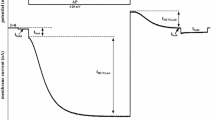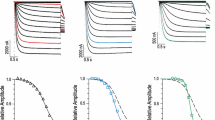Abstract
The nonlinear charge movements which occur during membrane depolarization of cardiac ventricular myocytes (Q ON) have been previously identified and separated, by kinetic and steady-state criteria, into constituent components arising from the gating of Na channels and Ca channels. In contrast, the nature and time course of the OFF charge movements (Q OFF), which follow membrane repolarization have not been as clearly established. In order to address this question cardiac Q OFF was studied using small-diameter, 17-dayold embryonic chick ventricular myocytes that can be rapidly and uniformly voltage-clamped. The application of brief (5.4 ms) depolarizing steps were employed to produce Na channel inactivation but little Ca channel inactivation. Following the return of the membrane potential to −100 mV Q OFF, measured as the gating current termed I gOFF, displayed two kinetic components. Double exponential fits to I gOFF yielded time constants of a few tenths of a millisecond for the fast component (I gOFFfast) and of 1–2 ms for the slower component (I gOFFslow). The time course and voltage dependence for the slower component suggested that it might be linked to the inactivation, and the recovery from inactivation, of Na channels. In order to identify these kinetic components double-pulse protocols were employed in which the duration of the prepulse and the interval separating the prepulse and test pulse were varied. The time course for the decay of I gOFFslow following a brief inactivating prepulse was similar to the time course for the recovery of the Na channel Q ON (Q NaRecov). Both I gOFFslow and Q NaRecov preceded the recovery of the Na channel (ionic) current. The recovery from inactivation of both the Na current and Q Na displayed a similar voltage dependence. These experiments have helped to identify the two components of cardiac Q gOFF and, therefore, will facilitate the interpretation of further biophysical and pharmacological studies concerning cardiac Na channel and Ca channel gating charge movements.
Similar content being viewed by others
References
Armstrong CM, Bezanilla F (1974) Charge movement associated with the opening and closing of the activation gates of the Na channels. J Gen Physiol 62:533–552
Bean BP, Rios E (1989) Nonlinear charge movement in mammalian cardiac ventricular cells. J Gen Physiol 94:65–93
Bezanilla F, Taylor F, Fernandez JM (1982) Distribution and kinetics of membrane dielectric polarization. I. Long-term inactivation of gating currents. J Gen Physiol 79:21–40
Field AC, Hill C, Lamb GD (1988) Asymmetric charge movement and calcium currents in ventricular myocytes of neonatal rat. J Physiol (Lond) 406:277–297
Hadley RW, Lederer WJ (1989) Intramembrane charge in guinea-pig and rat ventricular myocytes J Physiol (Lond) 415:601–624
Hamill OP, Marty A, Neher E, Sakmann B, Sigworth FJ (1981) Improved patch-clamp techniques for high-resolution current recording from cells and cell-free membrane patches. Pflügers Arch 391:85–100
Hanck DA, Sheets MF, Fozzard HA (1990) Gating currents associated with the Na channels in canine cardiac purkinje cells. J Gen Physiol 95:439–457
Josephson IR, Cui Y (1994) Cardiac gating charge movement: fast and slow components of Q OFF. Biophys J. 66:A135
Josephson IR, Cui Y (1994) Voltage- and concentration-dependent effects of lidocaine on cardiac Na channel and Ca channel gating charge movements. Pflügers Arch 428:485–491
Josephson IR, Sperelakis N (1990) Fast activation of cardiac Ca2+ channel gating charge by the dihydropyridine agonist, BAYK 8644. Biophys J 58:1307–1311
Josephson IR, Sperelakis N (1991) Phosphorylation shifts the voltage-dependent activation of cardiac Ca2+ channel gating currents. Biophys J 60:491–497
Josephson IR and Sperelakis N (1992) Kinetic and steady-state properties of Na+ channel and Ca2+ channel charge movements in ventricular myocytes of embryonic chick heart. J Gen Physiol 100:195–216
Keynes RP (1986) Modelling the Na channel. In:Richie JM, Keynes RD, Bolis L (eds) Ion channels in neural membranes. Liss, New York, pp 85–101
Keynes RP, Rojas E (1974) Kinetics and steady-state properties of the charged system controlling sodium conductance in the squid giant axon. J Physiol (Lond) 239:393–434
Pohl JA (1989) Recovery from charge immobilization in sodium channels of the frog node of Ranvier. Pflügers Arch 414:516–522
Rayner MD, Starkus JG (1989) The steady state distribution of gating charge in crayfish giant axons. Biophys J 55:1–19
Shirokov R, Levis R, Shirakova N, Rios E (1992) Two classes of gating current from L-type Ca channels in guinea pig myocytes. J Gen Physiol 99:863–896
Author information
Authors and Affiliations
Rights and permissions
About this article
Cite this article
Josephson, I.R., Cui, Y. Cardiac channel gating charge movements: recovery from inactivation. Pflugers Arch. 430, 682–689 (1995). https://doi.org/10.1007/BF00386162
Received:
Revised:
Accepted:
Issue Date:
DOI: https://doi.org/10.1007/BF00386162




